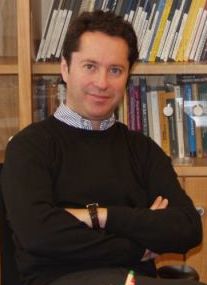Ignacio Cirac facts for kids
Quick facts for kids
Ignacio Cirac
|
|
|---|---|
 |
|
| Born |
Juan Ignacio Cirac Sasturain
October 11, 1965 |
| Alma mater | Complutense University of Madrid |
| Known for | Trapped ion quantum computer Quantum network models Cirac–Zoller CNOT W state Tensor network states |
| Awards | Prince of Asturias Award (2006) BBVA Foundation Frontiers of Knowledge Award (2008) Benjamin Franklin Medal (2010) Wolf Prize in Physics (2013) Max Planck Medal (2018) John Stewart Bell Prize (2019) Premio Innovación (Innovation Award) in the Premios Vanguardia (2023) |
| Scientific career | |
| Fields | Physicist |
| Institutions | Max Planck Institute of Quantum Optics |
| Thesis | Interaction of two-level atoms with non-classical states of light (1991) |
| Doctoral advisor | Luis Lorenzo Sánchez Soto |
| Doctoral students | Wolfgang Dür |
| Other notable students | Frank Verstraete, Guifré Vidal, Silke Weinfurtner |
Juan Ignacio Cirac Sasturain (born October 11, 1965), also known as Ignacio Cirac, is a famous Spanish physicist. He is a leading expert in the exciting fields of quantum computing and quantum information theory. His work helps us understand how tiny particles can be used to create super-fast computers. He received the important Wolf Prize in Physics in 2013 for his amazing discoveries.
Contents
Early Life and Education
Ignacio Cirac studied at the Complutense University of Madrid in Spain. He finished his studies there in 1988. This was the start of his journey into the world of physics.
A Career in Quantum Physics
Starting Research in the United States
In 1991, Cirac moved to the United States. He worked as a researcher with another famous physicist, Peter Zoller. They worked together at the Joint Institute for Laboratory Astrophysics in Colorado. This was a key time for his future work.
Teaching and Leading in Europe
From 1991 to 1996, Cirac taught physics in Spain. Later, in 1996, he became a professor in Innsbruck, Austria. In 2001, he became a director at the Max Planck Institute of Quantum Optics in Germany. He leads the Theory Division there, guiding other scientists. He also became an honorary professor at the Technical University of Munich.
Global Collaborations
Ignacio Cirac has worked with many top universities around the world. These include Harvard University, University of California, Santa Barbara, and the Massachusetts Institute of Technology. Working with different teams helps scientists share ideas and make new discoveries.
What is Quantum Physics?
Cirac's research focuses on quantum optics, which studies how light and matter interact at a very tiny level. He also works on quantum information theory. This field explores how information can be stored and processed using the rules of quantum mechanics.
His work with Peter Zoller was very important for quantum computing. They showed how to build a quantum computer using "ion traps." This means using tiny charged particles (ions) to store and process information. He also helped start the field of "quantum simulation," which uses quantum systems to model other complex systems.
Cirac has written over 440 articles in top science journals. He is one of the most cited authors in his field. This means many other scientists refer to his work in their own research.
Awards and Recognition
Ignacio Cirac has received many important awards for his contributions to science. These awards show how much his work has impacted the field of physics.
- In 2006, he received the Prince of Asturias Award. This is one of the most important awards in Spain.
- He won the BBVA Foundation Frontiers of Knowledge Award in 2008, sharing it with Peter Zoller.
- In 2010, he received the Benjamin Franklin Medal in Physics.
- He was awarded the Wolf Prize in Physics in 2013, again with Peter Zoller. This is a very prestigious international award.
- In 2018, he received the Max Planck Medal from the German Physical Society.
- Most recently, in 2023, he received the "Innovation" award at the La Vanguardia Prize ceremony.
These awards highlight his pioneering work in quantum physics and his role in shaping the future of quantum technology.
See also
 In Spanish: Juan Ignacio Cirac Sasturain para niños
In Spanish: Juan Ignacio Cirac Sasturain para niños
- Cirac–Zoller controlled-NOT gate

